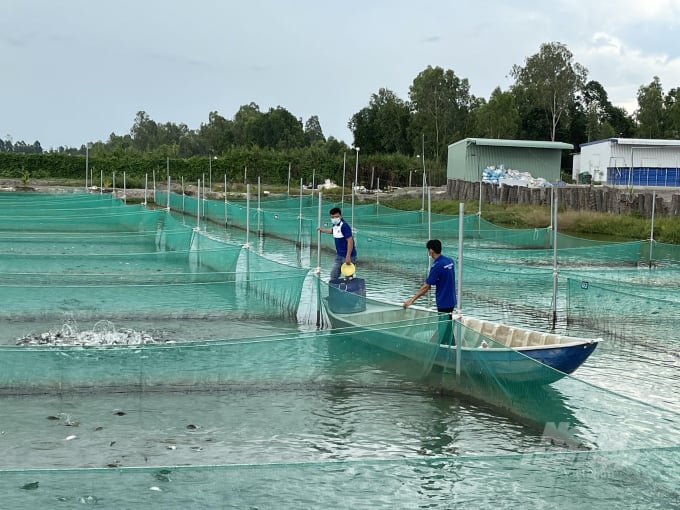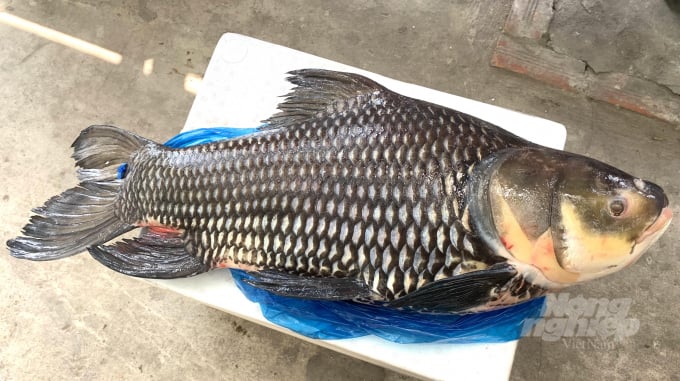November 24, 2025 | 21:55 GMT +7
November 24, 2025 | 21:55 GMT +7
Hotline: 0913.378.918
November 24, 2025 | 21:55 GMT +7
Hotline: 0913.378.918

In Can Tho city, Pham Nghia Company has invested in bronze featherback farming according to GlobalGAP standards. Photo: HD.
According to survey studies, the Mekong River has about 1,200 fish species representing many families, diverse in morphology and lifestyle. Particularly, the Mekong Delta has over 250 species of freshwater fish, of which about 50 species possess high economic value.
However, now only 50-100 species are caught on a regular basis and mainly in lowland areas where there are many inhabitants. It is estimated that in the downstream Mekong region, the volume of inland fishery catches is at least 2 million tons/year (nearly 3 million tons/year at a higher level). Most of the fish caught in the wild are whitefish migrating along the Mekong River.
In the past 30 years, with continuous scientific research efforts of institutes, universities and fisheries research centers in the Mekong Delta’s provinces and cities, now dozens of indigenous freshwater fish species have been artificially reproduced successfully. Of which, there are nearly 20 rare and precious fish species that have the potential to produce seeds and farm commercially to create high economic value.
Theo các công trình nghiên cứu khảo sát, sông Mê Công có khoảng 1.200 loài cá đại diện cho nhiều họ, đa dạng về mặt hình thái và đời sống. Riêng vùng ĐBSCL có trên 250 loài cá nước ngọt, trong đó khoảng 50 loài có giá trị kinh tế cao. Tuy vậy, hiện chỉ thỉnh thoảng có 50-100 loài đánh được thường xuyên và chủ yếu ở những vùng đồng bằng, nơi có nhiều cư dân. Theo ước tính, vùng hạ lưu sông Mê Công sản lượng nghề cá nội địa đánh bắt được ít nhất là 2 triệu tấn/năm và mức cao hơn có gần 3 triệu tấn/năm. Số lượng cá khai thác ngoài tự nhiên chiếm phần lớn là cá trắng di cư theo dòng sông Mê Công.

Many commercial fish households in the Mekong Delta grow freshwater catfish. Photo: HD.
Upon assessing indigenous fish varieties for the development of freshwater fish farming in the Mekong Delta, Assoc. Prof. Duong Nhut Long, Faculty of Fisheries - Can Tho University, said that freshwater fish species including whitefish and field-fish have achieved success in artificial reproduction, but only a few species have been produced and commercially farmed.
According to Assoc. Prof. Duong Nhut Long, the Mekong Delta region’s advantage is the diverse freshwater fish species, full of potential for exploitation that brings great economic benefits, typically tra fish is being developed following the global export commodity chain.
Recent research on artificial reproduction of some fish species has been focusing on some species that are in danger of depletion in order to protect and maintain native aquatic resources, such as: goatfish, ilish, scaly hairfin anchovy... At the same time, the selection and in-depth research on a few varieties of fish with high economic value, capable of high productivity, with output large enough to develop into a commodity chain from expansion of farming areas to farming activities for export is highly essential.
Prospective market observation of some species shows that bronze featherback has few bones, tough and sweet meat is being favored by European customers very much. In regard to farmed eel, the seed has been actively produced, after exploration, the product is favored by markets in many countries. As for snakeheads, bass, Snakeskin gourami, or some other field-fish species, farmers in the Mekong Delta are expanding the farming areas to supply the domestic market.
Research, selection and creation of high-quality agricultural varieties that can adapt to climate change for the region have been integrated into the program on “Research Development and Seed Production in service of the agricultural sector restructuring in the 2021-2030 period” in Decision No. 703/QD-TTg dated May 28th, 2020. The MARD has been directing to improve the research and production ability of agricultural and forestry plant varieties, livestock and aquatic breeds, specifically, the goal of developing three key varieties of the region (aquatic products, fruits, and rice) by 2025 and 2030 is clearly defined.
Translated by Samuel Pham

(VAN) Green transition is crucial for the Mekong Delta amid climate change and stricter standards, offering a path toward sustainability.

(VAN) Dong Thap promotes agricultural restructuring, forms large specialized farming zones, raises the value of agricultural products and develops toward ecological and high-tech directions.
/2025/11/22/4018-4-213342_747.jpg)
(VAN) The Mekong Delta Agricultural Experts Club has attracted 143 experts and researchers to participate in providing consultancy and contributing initiatives to the development of one million hectares of high-quality rice.

(VAN) Ca Mau’s development of OCOP products opens a path to increasing cooperatives value, helping boost income, expand markets, and affirm collective economy's role.

(VAN) Turning seemingly ordinary coconut shells into unique jewelry and artwork, Nguyen Bang Nhi spreads the value of local culture through her brand, Cocohand.

(VAN) Results from the Sustainable Durian Model Project in Dak Lak have confirmed the critical role of Yara Viet Nam in transferring advanced nutritional solutions to farmers.

(VAN) In Tuyen Quang province, livestock farmers have introduced effective models and innovative practices that significantly strengthen African Swine Fever prevention and control efforts.